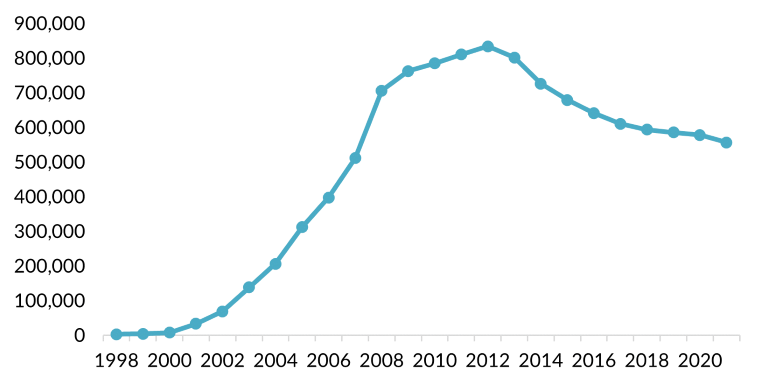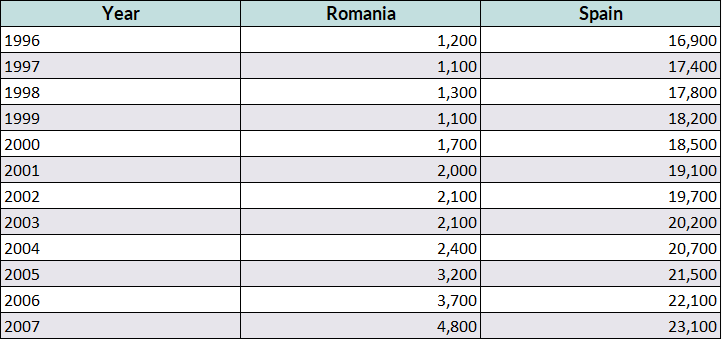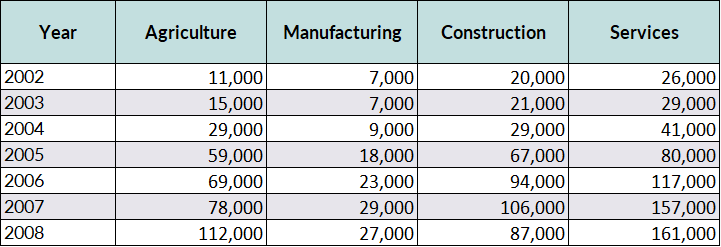You are here
Romanian Migration to Spain: Explaining an Unexpected Migrant Flow

A farmer in Spain stacks boxes of grapes. (Photo: ©FAO/Beatriz Moreno Escalona)
The largest origin countries for immigrants in Spain are mostly regional neighbors, states with historical ties, or Latin American nations where the Spanish language dominates. But the second largest national-origin group, with just over 550,000 individuals as of 2021, are Romanians. In fact, Romanians have represented one of the top three foreign-born populations in Spain since 2005, and as of 2020 Spain has hosted the third largest population of Romanian emigrants globally, trailing only Italy and Germany. Yet Spain’s Romanian immigrant population is relatively new and ballooned from only around 2,000 people as of 1990.
Many factors combined to account for the dramatic growth of Romanian migration to Spain over the last three decades. A booming Spanish economy and increase in Spaniards’ education levels led to the need for lower-skilled labor at the same time that Romania’s economy was in a precarious position due to the dissolution of the Soviet Union and Eastern Bloc. The establishment and strengthening of migrant networks proved to be vital in seeding Romanian migration to Spain. Additionally, migration policies in Spain and across the European Union encouraged immigration, particularly since the early 2000s.
Figure 1. Immigrants in Spain by Top Countries of Origin, 2021

Source: Spanish National Statistics Institute, “Población (españoles/extranjeros) por País de Nacimiento, sexo y año,” accessed August 23, 2022, available online.
Notably, the Romanian immigrant population in Spain peaked in 2012 at 830,000 and has declined since then. Part of this contraction is due to a growing Romanian economy, its accession to the European Union, and new restrictions in Spain following the late 2000s financial crisis. This article analyzes the drivers behind the growth and relative decline of the Romanian immigrant population in Spain since 1990.
The Push and Pull of Romanian Migration to Spain
Romanian migration to Spain can be traced to a variety of factors beginning in the 1990s. The collapse of the Soviet Union created significant social and economic turmoil in Romania, leading to few opportunities for personal or economic advancement. These hardships became the main push factors that incentivized Romanians to migrate to countries promising increased opportunity, such as Spain.
Figure 2. Romanian-Born Population in Spain, 1998-2021

Source: Spanish National Statistics Institute, “Población (españoles/extranjeros) por País de Nacimiento, sexo y año.”
However, these push factors would be less consequential if there were no pull factors in Spain that made it an attractive destination. A prime incentive for the move from Romania to Spain: wages, which on average have been dramatically higher in Spain. For instance, an average worker in Spain might expect to earn more than 15 times what they could in Romania in the late 1990s (see Table 1). Moreover, employment in Spain tended to be available, due to the country’s rapid economic growth powered in large part by the booming construction and real estate sectors. From 1991 to 2001, Spain’s annual gross domestic product (GDP) per capita grew on average by 2.5 percent, outpacing the United States (2 percent) and the combined nations of the Organization for Cooperation and Development (OECD; 1.8 percent). Between 1995 and 2001, the Spanish economy generated on average 670,000 new jobs annually, a large majority in immigrant-dense industries such as agriculture and construction.
Table 1. Average Annual Salary in Romania and Spain in Euros, 1996-2007

Sources: Organization for Economic Cooperation and Development, “Average Annual Wages,” accessed August 23, 2022, available online; Datosmacro, “Rumanía – Salario Medio,” accessed August 23, 2022, available online
Another reason Spain was an attractive destination was the largely welcoming attitude of its native population. One explanation for this is Spaniards’ desire to reciprocate the same welcome they received in decades prior, such as during the dictatorship of Francisco Franco, when many went abroad. According to opinion surveys, 50 percent of Spain’s population was in favor of Romania’s accession to the European Union in 1999, eight years before the latter was incorporated into the bloc, and 40 percent believed that immigration in general would not have any negative effects. By comparison, just 26 percent of French people at the time supported Romania’s EU accession. This combination of Romanians seeking new beginnings and Spain’s provision of ample employment, significantly higher wages, and a more welcoming environment than other traditional migrant destinations led to a vast uptick in migration throughout the late 1990s and 2000s.
In fact, between 2000 and 2007, Spain was Europe’s leading immigration country. Its foreign-born population grew by 4.8 million over that time and the immigrant share of Spain’s population jumped from 2 percent to 12 percent—a remarkable rate of growth over a few short years.
Figure 3. Foreign-Born Population in Spain, 1998-2021

Source: Spanish National Statistics Institute, “Población (españoles/extranjeros) por País de Nacimiento, sexo y año.”
A Dual Labor Market Emerges
Historically, the demand for new workers had been filled by rural Spaniards migrating internally towards cities. Yet by the 1980s and 1990s, there were no longer enough rural migrants to fill open positions, making foreign workers increasingly attractive.
A second, more important, reason Spain was hungry for foreign-born workers was the increasing level of education of many Spaniards. Between 1987 and 2001, the share of native-born Spaniards with less than a secondary education declined from 56 percent to 26 percent. Meanwhile, the number of those with a university education rose by 369 percent during these 14 years. Higher educational rates for native-born workers created a situation in which the country needed to tap new pools for low-skilled workers willing to do the jobs for which Spaniards were overqualified.
Table 2. Romanian Workers in Spain in Select Employment Sectors, 2002-08

Source: Spanish Ministry of Inclusion, Social Security, and Migration, “Anuarios Estadísticos de Inmigración,” accessed August 30, 2022, available online
This increase in education among the native born led to a classic dual labor market in which Spaniards tended to occupy white-collar jobs while immigrants filled positions requiring less education and commonly referred to as 3D (dirty, difficult, and dangerous), such as agriculture, construction, and manufacturing. Partly because these jobs are more physically demanding, Romanian arrivals tended to be younger than native-born Spaniards and other immigrants.
Figure 4. Average Age of Spanish Residents by Place of Origin, 2022

Source: Spanish National Statistics Institute, “Population and Average Age by Nationality and Sex,” accessed August 23, 2022, available online
Migrant Networks
Romanian migrant networks in Spain have sent information back to their homeland about their experiences, thus facilitating future migration. Large numbers of Romanians first migrated to Spain in the early 1990s and successfully integrated into Spanish society. One key to this success was an unlikely linguistic similarity; Romanian, like Spanish, is a romance language and the only one of its kind in Eastern Europe. This first generation was able to establish itself securely enough in Spain so that future Romanians could take advantage of later policy changes that made it easier to migrate.
Given the robustness of this migration corridor, many scholars have studied these networks. For instance, Tim Elrick and Oana Ciobanu conducted fieldwork in two Romanian villages, Feldru and Luncavița. In Feldru, many inhabitants worked in agriculture and moved for work frequently under the former Communist regime, often establishing new lives abroad. This led the village to create a strong culture of migration. Given that extensive networks were already established, residents of Feldru had an easier time migrating to countries such as Spain once conditions were conducive. Residents of Luncavița, meanwhile, could historically find employment nearby in agriculture, fishing, and manufacturing, and thereby felt less pressure to emigrate. However, in the late 1990s, many jobs disappeared when factories closed, leading to an increased desire for international migration. Yet, the lack of a culture of migration or sophisticated migrant network such as had existed in Feldru meant these movements tended to be based on family connections.
Since Romanians began migrating to Spain, Madrid, the capital and largest city, has been by far the most popular destination, hosting around one-quarter of all Romanians in the country. As such, the city’s migratory networks are very robust. Within it, Romanians tend to coalesce in the east, around municipalities such as Alcalá de Henares, Arganda del Rey, Coslada, and Torrejon de Ardoz, where many have been able to quickly find employment due to family connections, religious organizations such as the Romanian Adventist church, and other institutions. These networks have proved invaluable over the years, such as during Spanish regularization campaigns, when they made it easier for eligible Romanians to participate.
Immigration Policy Facilitated Movement
Before the 1980s, Spain was considered a country of emigration, with millions of citizens pursuing new beginnings elsewhere in Europe or in Latin America. One major factor behind this trend was the Spanish Civil War (1936-39), which caused such immense destruction and suffering throughout the country that its economy did not fully recover until well into the 1950s, leading the 1940s to be referred to as the años del hambre, or years of hunger.
The Franco dictatorship, which lasted from the end of the Civil War until his death in 1975, was another driver. Franco’s regime created a repressive police state that imprisoned, exiled, or executed around 2 million people. Additionally, Franco’s attempt to implement a neoliberal economy led to a loss of up to 70 percent of workers’ real wages compared to their 1936 levels at the worst of the crisis. All told, more than 1.5 million Spaniards emigrated between 1950 and 1975, increasingly to other parts of Europe needing additional labor for rebuilding efforts following World War II.
Figure 5. Emigration from Spain by Destination, 1950-75

Source: Blanca Garcés-Mascareñas, Labour Migration in Malaysia and Spain (Amsterdam: Amsterdam University Press, 2012).
By the mid-1980s, this net outflow ceased, and Spain became primarily a migrant destination. This was due in large part to Franco’s modernization efforts in the 1960s and 1970s, which were facilitated primarily by internal rural-urban migration of workers. The economy boomed in the 1980s, following his death and the return to democracy, prompting a need for more labor. At this point Spain started to formulate a migration policy, although most experts agree that this was only done to join the European Union’s predecessor in 1986.
The Romanian migrant population increased slowly in the 1990s but ballooned in the new millennium. A 2002 bilateral labor migration agreement that the Spanish government signed with Romania allowing Romanians to work temporarily in Spain was a critical juncture. This agreement was one of the first of its kind signed by the Spanish government and its first with a country in Eastern Europe.
That same year, Romanians became eligible for visa-free travel to the European Union for stays of less than three months, helping drive their movement throughout the bloc. Romanians looking to stay in a Member State for longer than three months had to show that they could support themselves financially, possess a valid travel visa, or were moving for work.
This change also drove migration to Spain, in part because it became suddenly cheaper to enter the European Union. The costs to secure a visa—estimated to have been around 2,000 euros in some instances—disappeared overnight. Moreover, many Romanians now had the opportunity to temporarily migrate to work without the need for authorization for three months, then return or overstay their visit in Spain. By 2005, the number of Romanians staying in EU Member States beyond their permitted three months became such a big issue the Romanian government passed Decree Law 28/2005, allowing it to confiscate the passports of overstayers. Still, the Romanian population in Spain grew nearly sixfold between 2002 and 2006, from fewer than 69,000 to more than 397,000.
More than 1 Million People Regularized
Each time Spain reformed its migration laws after joining the European Union, it also offered opportunities for unauthorized immigrants to obtain legal status, which helped provide a pathway for many Romanians and other migrants. Between 1985 and 2005, the Spanish government conducted six regularization campaigns, resulting in more than 1 million people gaining legal status. Romanians were prime beneficiaries of these campaigns, especially after 1996. Since Romanians started to arrive in Spain in the early 1990s, they had established networks to help facilitate legalization in the 1996, 2000, 2001, and 2005 regularization campaigns. By the end of 2006, 60 percent of Romanians living in Spain legally had acquired status through one of the final three regularization campaigns. Individuals who regularized were given one-year residency and work permits that were renewable annually until they were eligible to apply for permanent legal status after five years of continuous legal residency.
Similarly, the arraigo or “rootedness” program created in 2004 provided irregular migrants another way to legalize their status, on a case-by-case basis. There are two pathways, social and labor, with differing requirements, and many unauthorized Romanians were able to meet the conditions for at least one.
Declining Numbers of Romanians in Spain Today
When their country became an EU Member State in 2007, Romanian citizens received the right to visa-free movement within the European free-movement zone, needing to show only a passport or identity document. For stays longer than three months, Romanians had to demonstrate that they could support themselves financially. However, EU accession marked the start of less restrictive travel—not the right to work at destination. Two years later, Spain allowed Romanians full access to its labor market, closed it off in August 2011 amid the Eurozone crisis, and then reopened access in 2014.
This policy change helps explain why the number of Romanians in Spain has declined by 33 percent since 2012. Another key factor is the improving economic situation in Romania, with average annual wages topping 12,000 euros as of 2021, a more than sixfold increase from 2001. In general, emigration from Romania to all countries seems to be plateauing. The number of Romanian emigrants worldwide tripled between 2000 and 2010, from 1.1 million to more than 3.3 million, and then increased much more slowly over the following decade, rising to just under 4 million by 2020, according to UN Population Division figures.
Importantly, the decline in the Romanian population in Spain does not seem to be the result of anti-Romanian or anti-immigrant sentiment. While upticks in anti-Romanian hostility did surface during the Eurozone crisis due to the economic turmoil, Spain has historically been more welcoming to immigrants than other Western European countries. In recent years, this has started to change as the rise of a new far-right political party, Vox, has coincided with increases in more hardline viewpoints among the Spanish population.
The decreasing number of Romanian immigrants will likely continue due to the significant impact of the COVID-19 pandemic on industries necessitating only lower levels of education, where Romanians tend to cluster, as well as improving economic conditions in Romania and the relative difficulty of obtaining permanent employment in Spain. Yet Romania is also facing spillover effects from the war in Ukraine, including tens of thousands of Ukrainian refugees, as well as rising inflation that could impact future economic growth. Deciphering what these trends mean for Romanian migration, and whether this marks the start of a new era, will take years to fully understand.
Sources
Bruquetas-Callejo, María, Blanca Garcés-Mascareñas, Ricard Morén-Alegret, Rinus Penninx, and Eduardo Ruiz-Vieytez. 2011. The Case of Spain. In Migration Policymaking in Europe: The Dynamics of Actors and Contexts in Past and Present, eds. Rinus Penninx, Giovanna Zincone, and Maren Borkert. Amsterdam: Amsterdam University Press.
Cachón Rodríguez, Lorenzo. 2002. La formación de la “España inmigrante.” REIS: Revista Española de Investigaciones Sociológicas 97: 95-126. Available online.
CEPS Projectes Socials. 2011. National Report: Romanian Immigrants in Spain. Barcelona: CEPS Projectes Socials. Available online.
Datosmacro. N.d. Rumanía-Salario Medio. Accessed August 23, 2022. Available online.
De Haas, Hein, Stephen Castles, and Mark J. Miller. 2020. The Age of Migration: International Population Movements in the Modern World. New York: Guilford Press.
Elrick, Tim and Oana Ciobanu. 2009. Migration Networks and Policy Impacts: Insights from Romanian-Spanish Migrations. Global Networks 9 (1): 100-16.
Encarnación, Omar. 2014. Democracy without Justice in Spain: The Politics of Forgetting. Philadelphia: University of Pennsylvania Press.
Escudero, Rafael. 2014. Road to Impunity: The Absence of Transitional Justice Programs in Spain. Human Rights Quarterly 36 (1): 123-46.
European Commission. 2011. The Commission Accepts that Spain Can Temporarily Restrict the Free Movement of Romanian Workers. Memo 11/554, European Commission, Brussels, August 11, 2011. Available online.
Eurostat. N.d. Immigration by Age Group, Sex and Country of Previous Residence-migr_imm5prv. Accessed August 23, 2022. Available online.
Finotelli, Claudia and Joaquín Arango. 2011. Regularisation of Unauthorised Immigrants in Italy and Spain: Determinants and Effects. Documents D’anàlisi Geogràfica 57 (3): 495-515.
Gabriel Anghel, Remus. 2008. Changing Statuses: Freedom of Movement, Locality and Transnationality of Irregular Romanian Migrants in Milan. Journal of Ethnic and Migration Studies 34 (5): 787-802.
Garcés-Mascareñas, Blanca. 2012. Labour Migration in Malaysia and Spain. Amsterdam: Amsterdam University Press. Available online.
González-Enríquez, Carmen. 2009. Spain, the Cheap Model. Irregularity and Regularisation as Immigration Management Policies. European Journal of Migration and Law 11 (2): 139-57. Available online.
González-Enríquez, Carmen and Sebastian Rinken. 2021. Spanish Public Opinion on Immigration and the Effect of VOX. Madrid: Real Instituto Elcano. Available online.
Hadden, Gerry and Marco Werman. 2011. Why Romanians are Not Welcome in Spain. PRX’s The World, December 8, 2011. Available online.
Kingdom of Spain and Romania. 2002. Agreement between the Kingdom of Spain and Romania on the Regulation and Organisation of Labour Force Migratory Flows between Both States. January 23, 2002. Available online.
Levionnois, Charlotte, Gilles Spielvogel, Michele Tuccio, and Erik Vickstrom. 2019. Talent Abroad: A Review of Romanian Emigrants. Paris: Organization for Economic Cooperation and Development Publishing. Available online.
Marcu, Silvia. 2014. Geography of Belonging: Nostalgic Attachment, Transnational Home and Global Mobility among Romanian Immigrants in Spain. Journal of Cultural Geography 31 (3): 326-45.
Marzocchi, Ottavio. 2022. Free Movement of Persons. Fact Sheet, European Parliament, Strasbourg, France, May 2022. Available online.
McCabe, Kristen, Serena Yi-Yang Lin, Hiroyuki Tanaka, and Piotr Plewa. 2009. Pay to Go: Countries Offer Cash to Immigrants Willing to Pack Their Bags. Migration Information Source, November 5, 2009. Available online.
Organization for Economic Cooperation and Development (OECD). N.d. Average Annual Wages. Accessed August 23, 2022. Available online.
Peixoto, João et al. 2012. Immigrants, Markets and Policies in Southern Europe: The Making of an Immigration Model? In European Immigrations: Trends, Structures and Policy Implications, ed. Marek Okólski. Amsterdam: Amsterdam University Press. Available online.
Portes, Alejandro, Rosa Aparicio, and William Haller. 2016. Spanish Legacies: The Coming of Age of the Second Generation. Berkeley, CA: University of California Press.
Rodríguez-Planas, Núria and Natalia Nollenberger. 2014. A Precarious Position: The Labor Market Integration of New Immigrants in Spain. Washington, DC: Migration Policy Institute. Available online.
Sandu, Dumitru et al. 2009. Romanian Communities in Spain. Bucharest: Soros Foundation Romania. Available online.
Spanish Ministry of Inclusion, Social Security, and Migration. N.d. Anuarios Estadísticos de Inmigración. Accessed August 23, 2022. Available online.
Spanish National Statistics Institute. N.d. Population and Average Age by Nationality and Sex. Accessed August 23, 2022. Available online.
---. N.d. Population (Spaniards/Foreigners) by Country of Birth, Sex and Year. Accessed August 23, 2022. Available online.
Stan, Razvan. 2006. Irregular Migration of Romanian Workers to the European Union. Budapest: Center for Policy Studies. Available online.
United Nations Population Division. N.d. International Migrant Stock. Accessed August 23, 2022. Available online.
Viruela Martínez, Rafael. 2011. The Romanian Migrants in Spain. An Exceptional Migratory Flow. International Review of Social Research 1 (1): 31-59. Available online.
World Bank. N.d. GDP per Capita Growth (annual %)-NY.GDP.PCAP.KD.ZG. Accessed August 23, 2022. Available online.


